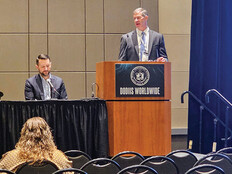The federal IT workforce is at a crossroads. On average, for every tech worker under 30, there are nearly five at or near retirement age, according to the most recent data from the Office of Personnel Management.
Civilian agencies are more unbalanced than the military, with 7.4 older workers for every one under 30. And the Veterans Affairs Department has the widest ratio, with 19 workers over 60 for every 1 under 30.
The situation has reached the point where Kevin Cooke Jr., principal deputy CIO for the Department of Housing and Urban Development, can joke — as he did at the Imagine Nation ELC 2018 conference — about retiring and forming a government contracting company to troubleshoot COBOL, and get several audience members, also current government employees, to offer their services.

How Feds Can Find the Best People
It’s not that the federal government doesn’t want to hire younger workers; far from it. It’s that government isn’t always seen as an attractive place to work. The private sector can offer fancier perks and higher salaries, for one thing, and in the wake of the 35-day partial government shutdown, the federal sector may not seem an entirely stable place to be.
Defense Department CIO Dana Deasy, who came to government after nearly four decades in the private sector, also thinks that federal recruiters are not always where they need to be when people are making career decisions. He likes to tell his own story, in which government employment was never presented as an option when it came time for him to make a change.
Any enterprise that is attempting to modernize — as the federal government is famously trying to do — needs to find the best people wherever it can. The government especially must find new workers as its older ones continue to retire at a rate faster than they can be replaced.
“Digital transformation is as much about people as it is technology,” write Mike Verbeck and Victor Marchetto in “The Digital Transformation Insight Report” by CDW. “When organizations exclude people from the process, they run a much higher risk of failure.”
Reskilling programs being spearheaded by various agencies are an excellent start to the search for additional workers. This summer, the new Federal Cybersecurity Reskilling Academy is taking on its first class of non-IT federal workers, giving them training in cyberdefense analysis through a program cosponsored by the Office of Management and Budget, the Education Department and the CIO Council.
Other pilot programs are being planned elsewhere in government for the rest of the year, all aimed at people who are not IT specialists. And some agencies are turning to talent analytics programs to keep track of workers who might have the skills to work in cyber once they’re trained.
MORE FROM FEDTECH: Find out where to turn when the cybersecurity hiring well runs dry.
Agencies Must Get Creative to Uncover Unexpected Talent
Creative thinking about where to find new workers — and how to define a potential IT employee — is what’s necessary in this fast-moving age of transformation. When you’re a large enterprise, such as the federal government, facing a mass exodus of older workers as your pipeline of replacements is running dry, it’s even more important.
“Digital transformation usually involves new partnerships and skill sets that the organization hasn’t needed before,” writes Link Simpson in the CDW report. “To address these challenges and turn the promise of digital transformation into reality, organizations need to think big, act small, and move fast.”
The federal government clearly has the will to act upon its IT needs, and it may even have the money: The president’s fiscal 2020 budget request includes nearly $88 billion for IT — $49 billion for civilian agencies and $36 billion for military.
Workers already on board are doing the hard work at the beginning of this long modernization process; all they need now are a few thousand more hands on deck for both the government and the American people to see the payoff.











